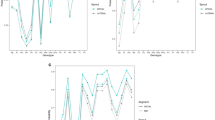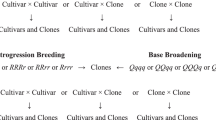Abstract
The genetics of tissue culture response in potato has been examined by analysing a sample of dihaploids (2n=2x=24) extracted from tetraploid parents (4n=4x=48). The genotypes were screened for rate of nodal multiplication, in vitro tuberisation, regeneration from leaf discs and protoplast plating efficiency. Significant differences were detected between dihaploids for the traits measured and this indicates that tissue culture response in the tetraploid parents must be in the heterozygous condition. Estimates of the broad sense heritabilities were calculated together with the number of genes or effective factors involved in the control of the traits. These estimates indicate that tissue culture response in potato is under relatively simple genetic control and “blocks of genes” may be located on specific chromosomes. The inheritance of RFLP markers in the segregating dihaploid population was also monitored and the potential of using molecular markers linked to gene(s) controlling tissue culture response is discussed.
Similar content being viewed by others
References
Fish N & Jones MGK (1988) A comparison of tissue culture response between related tetraploid and dihaploid S. tuberosum genotypes. Plant Cell Tiss. Org. Cult. 15: 211–222
Tan MMC, Colijn-Hooymans CM, Lindhout WH & Kool AJ (1987) A comparison of shoot regeneration from protoplasts and leaf discs of different genotypes of the cultivated tomato. Theor. Appl. Genet. 75: 105–108
Murashige T & Skoog F (1962) A revised medium for rapid growth and bioassays with tobacco tissue culture. Physiol. Plant. 15: 473–497
Foulger D & Jones MGK (1986) Improved efficiency of genotype-dependent regeneration of important potato cultivars. Plant Cell Rep. 5: 72–76
Saghai-Maroof MA, Soliman KM, Jorgensen RA & Allard RW (1984) Ribosomal DNA space-length polymorphisms in barley. Mendelian inheritance, chromosomal location and population dynamics. Proc. Natl. Acad. Sci., USA 81: 8014–8018
Reed KC & Mann DA (1985) Rapid transfer of DNA from agarose gels to nylon membranes. Nuc. Acids Res. 13: 7207–7221
De Maine MJ (1978) Field resistance to late blight and potato root eelworm in group tuberosum dihaploids. Euphytica 27: 305–315
De Maine MJ (1982) An evaluation of the use of dihaploids and unreduced gametes in breeding for quantitative resistance to potato pathogens. J. Agric. Sci. (Camb.) 99: 79–83
De Maine MJ, Farrer LA & Phillips MS (1986) Breeding for quantitative resistance to potato cyst nematode (Globodera pallida) in tetraploid potatoes using dihaploids and unreduced gametes. Euphytica 39: 1001–1006
Mather K & Jinks JL (1982) Biometrical Genetics, 3rd edition. Champman and Hall, London
Croft JH & Smichen G (1965) Natural variation among monokaryons of Collybria velutipes. Am. Nat. 94: 451–462
Powell W, Caligari PDS & Jinks JL (1985) The usefulness and limitations of estimating the number of genes in a barley breeding programme. J. Agric. Sci. (Camb.) 105: 285–290
Tanksley SD & Orton TJ (1983) Isozymes in Plant Breeding and Genetics. Elsevier, Amsterdam
Stuber CW, Edwards D & Wendel JF (1987) Molecular marker-facilitated investigation of quantitative trait loci in maize. II. Factors influencing yield and its component traits. Crop Sci. 27: 639–648
Bonierbale MW, Plaisted RL & Tanksley SD (1988) RFLP maps based on a common set of clones revealed modes of chromosomal evolution in potato and tomato. Genetics 120: 1095–1103
Gebhardt C, Ritter E, Debener T, Schachtschabel U, Walkmeier B, Uhrig H & Salamini F (1989) RFLP analysis and linkage mapping in Solanum tuberosum. Theor. Appl. Genet. 78: 65–75
Gebhardt C, Blomendahl C, Schachtschabel U, Debener T, Salamini F & Ritter E (1989) Identification of 2n breeding lines and 4n varieties of potato (Solanum tuberosum ssp tuberosum) with RFLP fingerprints: 16–22
Author information
Authors and Affiliations
Rights and permissions
About this article
Cite this article
Coleman, M., Waugh, R. & Powell, W. Genetical analysis of in vitro cell and tissue culture response in potato. Plant Cell Tiss Organ Cult 23, 181–186 (1990). https://doi.org/10.1007/BF00034429
Received:
Accepted:
Issue Date:
DOI: https://doi.org/10.1007/BF00034429




